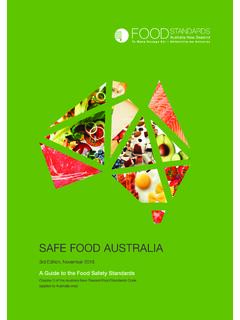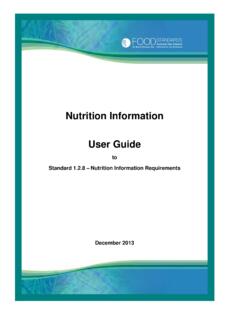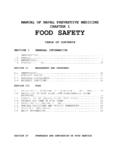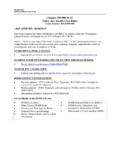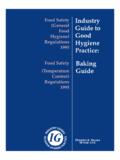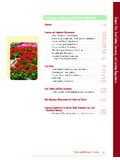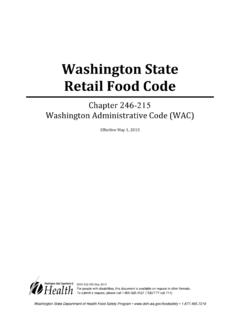Transcription of SAFE FOOD AUSTRALIA
1 safe food AUSTRALIA3rd Edition, November 2016A Guide to the food safety StandardsChapter 3 of the AUSTRALIA New Zealand food Standards Code (applies to AUSTRALIA only) safe food AUSTRALIAA Guide to the food safety StandardsChapter 3 of the AUSTRALIA New Zealand food Standards Code ( AUSTRALIA only) Standard Interpretation and Application Standard food safety Practices and General Requirements Standard food Premises and EquipmentThird Edition, November 2016 IIFOOD STANDARDS AUSTRALIA NEW ZEALAND safe food AUSTRALIAA GUIDE TO THE food safety STANDARDS THIRD EDITION NOVEMBER 2016 food STANDARDS AUSTRALIA NEW ZEALAND safe food AUSTRALIA food Standards AUSTRALIA New Zealand 2016 ISBN: 978-0-642-34593-6 Published November 2016 food Standards AUSTRALIA New Zealand (FSANZ) supports and encourages the dissemination and exchange of information.
2 Information in this document is provided under a Creative Commons Attribution AUSTRALIA (CC BY ) Licence, except for the food Standards AUSTRALIA New Zealand logo. An electronic version of this work is available on the FSANZ website at may copy, distribute, transmit and adapt the material in this publication by the CC BY licence for commercial and non-commercial purposes; but you must attribute the work in the following manner: food Standards AUSTRALIA New attribution must not, in any way, suggest that FSANZ endorses you or your use of the more information email AUSTRALIA PO Box 5423 Kingston ACT 2604 AUSTRALIA Ph: +61 2 6271 2222 Fax: +61 2 6271 2278 FSANZ New Zealand PO Box 10559 The Terrace, Wellington, 6143 New Zealand Ph: +64 4 473 5630 Fax: +64 4 473 9855 IIIFOOD STANDARDS AUSTRALIA NEW ZEALAND safe food AUSTRALIAAUSTRALIA NEW ZEALAND food STANDARDS CODE chapter 3 ( AUSTRALIA ONLY)STATUS OF GUIDES tatus and context of the documentThis document relates to three food safety standards in chapter 3 of the AUSTRALIA New Zealand food Standards Code (the Code).
3 These standards apply only in AUSTRALIA . They Interpretation and food safety Practices and General food Premises and EquipmentThe information provided in this document is not legally document was prepared by food Standards AUSTRALIA New Zealand (FSANZ) to assist government agencies responsible for enforcing the Code in and territory food agencies are primarily responsible for interpretation and enforcement of the Code in AUSTRALIA . This is because the food standards that comprise the Code are applied in AUSTRALIA by state and territory food laws. It is the state and territory food laws that make failure to comply with Code requirements an offence. At the Commonwealth level, the Commonwealth Department of Agriculture and Water Resources administers the Imported food Control Act 1992 (Cth), which applies the food standards to imported food .
4 These agencies work together through the Implementation Subcommittee for food Regulation (ISFR) to ensure food laws are implemented and enforced prepared and published this document at the request of ISFR. FSANZ is not an enforcement agency and cannot provide advice or guidance on food compliance document will be reviewed and amended as necessary. Readers may contact the food safety and Response Section of FSANZ if they have feedback. Email: Standards AUSTRALIA New Zealand makes no warranty or representation regarding the completeness, accuracy, or currency of any information contained in this document or publication or that such information will be Standards AUSTRALIA New Zealand does not accept any legal liability or responsibility for any harm, injury, loss, damages, or costs directly or indirectly sustained by any person as a result of any use of, or reliance on, or interpretation of, the information contained in this information contained in this publication is not and should not be relied upon as legal advice nor be regarded as a substitute for legal advice.
5 Any person relying on this information should seek independent legal advice in relation to any queries they may have regarding obligations imposed under the standards in the AUSTRALIA New Zealand food Standards NEW ZEALAND food STANDARDS CODE chapter 3 ( AUSTRALIA ONLY)CONTENTSIII11 food STANDARDS AUSTRALIA NEW ZEALAND safe food AUSTRALIAC ontentsStatus and context of the document IntroductionUsing this guide Standard Interpretation and Application 31 42 103 124 Interpretation Meaning of safe and suitable food General application of the food safety Standards Compliance 12 Standard food safety Practices and General Requirements 13141418 Division 1 Interpretation and application 1 Interpretation 2 Application of this Standard Division 2 General requirements 18183 food handling skills and knowledge 4 Notification 22 Division 3 food handling controls 24242932425 6 7 8 9 49525410 11 12 food receiptFood storage food processing food displayFood packaging food transportation food disposal food recall 5861 Division 4 Health and hygiene
6 Requirements Subdivision 1 Requirements for food handlers 61616213 14 15 General requirement (on food handlers) Health of food handlers Hygiene of food handlers 65 Subdivision 2 Requirements for food businesses 72727416 17 18 Health of persons who handle food duties of food businesses Hygiene of food handlers duties of food businesses General duties of food businesses 77 Division 5 Cleaning, sanitising and maintenance 79798019 20 21 Cleanliness Cleaning and sanitising of specific equipment Maintenance 84 VIFOOD STANDARDS AUSTRALIA NEW ZEALAND safe food AUSTRALIAFOOD STANDARDS AUSTRALIA NEW ZEALAND safe food AUSTRALIAA GUIDE TO THE food safety STANDARDS THIRD EDITION NOVEMBER 2016 CONTENTSD ivision 6 Miscellaneous 8522 Temperature measuring devices 8523 Single use items 9024 Animals and pests 9225 Alternative methods of compliance 95 Standard food Premises and Equipment 99 Division 1 Interpretation and application 1001 Interpretation 1002 Application of this Standard 101 Division 2 Design and construction of food premises 1023 General requirements 1024 Water supply 1085 Sewage and waste water disposal 1136 Storage of garbage and recyclable matter 1147
7 Ventilation 1168 Lighting 119 Division 3 Floors, walls and ceilings 1209 Application 12010 Floors 12011 Walls and ceilings 123 Division 4 Fixtures, fittings and equipment 12712 General requirements 12713 Connections for specific fixtures, fittings and equipment 13414 Hand washing facilities 136 Division 5 Miscellaneous 14215 Storage facilities 14216 Toilet facilities 14317 food transport vehicles 144 Appendices 147 Appendix 1: Potentially hazardous foods 148 Appendix 2: The use of time as a control for potentially hazardous food 151 Appendix 3: Limits for food processes 158 Appendix 4: Foods requiring special care 162 Appendix 5: Cooling of meats after cooking 172 Appendix 6: Cleaning and sanitising surfaces and utensils 173 Appendix 7: Pest management 182 Appendix 8: Template examples 183 Appendix 9: Temporary and mobile food premises 191 Appendix 10: Home-based food businesses 204 Resources and References2111 food STANDARDS AUSTRALIA NEW ZEALAND safe food AUSTRALIAAUSTRALIA NEW ZEALAND food STANDARDS CODE chapter 3 ( AUSTRALIA ONLY)INTRODUCTIONI ntroductionThere are five national food safety standards that apply in AUSTRALIA : Interpretation and Application food safety Programs food safety Practices and General Requirements food Premises and Equipment food safety Programs for food Service to Vulnerable standards provide a risk-based, preventative approach to providing safe and suitable food .
8 They are based on the principle that food safety is best ensured by implementing food hygiene controls at each stage of food handling and that additional risk management tools, such as food safety programs, may be required for high-risk food industry the five standards, Standards , and apply to all Australian food businesses and establish fundamental requirements for minimising food safety risks. safe food AUSTRALIA provides information to assist with understanding the intent of these three standards, including the food safety outcome(s) information in this document is primarily intended to assist enforcement authorities but it may also be useful for food businesses. safe food AUSTRALIA includes clarifications, examples and recommendations based on scientific evidence and industry best practice. It is not an interpretation of the AUSTRALIA New Zealand food Standards Code ( food Standards Code) and is not a legally binding document.
9 The food Standards Code is enforced in all Australian jurisdictions through state and territory food Acts. food businesses needing information on complying with the food safety standards should contact their local enforcement agency for safety risks will vary from business to business depending on the nature of the food business and the food handling operations undertaken. For example, factors such as inherent hazards in the food , the potential for contamination during food handling and how the food is processed contribute to food safety risks. Information provided in safe food AUSTRALIA highlights factors that may contribute to these risks at each step of the food handling process. Appendixes also provide technical and practical this guide The text of the standards is included in bold type throughout the explanatory sections of thedocument for convenient reference.
10 The authoritative versions of these standards are on theAustralian Government Federal Register of Legislation, accessible from the FSANZ website. The intended outcome for each clause of the standards is set out in the lightly shaded boxthat precedes the explanation for that clause. Examples aim to highlight key principles and illustrate the intent of the , they are examples only and the options provided are not INTERPRETATION AND APPLICATION4 STANDARD GUIDE TO THE food safety STANDARDS THIRD EDITION NOVEMBER 2016 food STANDARDS AUSTRALIA NEW ZEALAND safe food AUSTRALIAFOOD STANDARDS AUSTRALIA NEW ZEALAND safe food AUSTRALIASTANDARD INTERPRETATION AND APPLICATION1 InterpretationStandard defines terms that are used only in this standard or in both Standard and Terms that are used in only one of the other standards are defined in the standard in which they are definitions given in the food safety standards apply to the interpretation of these standards whether or not the words are defined in state and territory food of the definitions in Standard refer to the Act.

